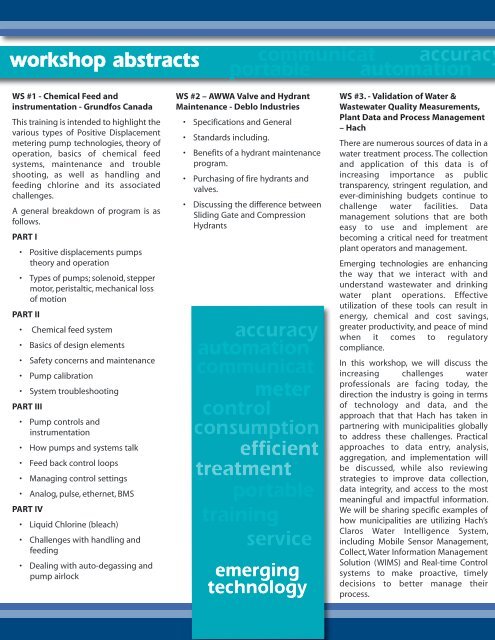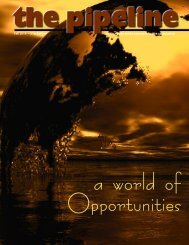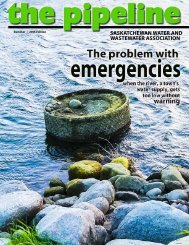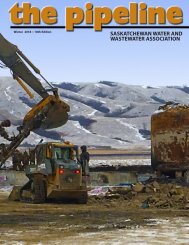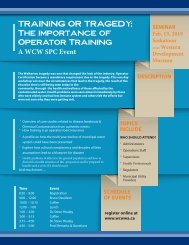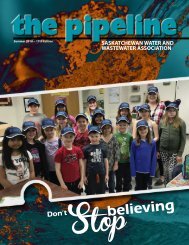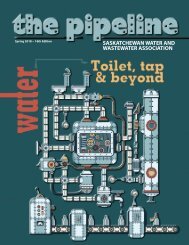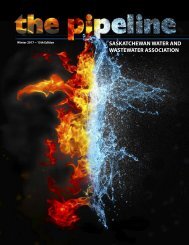September 2019 Publication
You also want an ePaper? Increase the reach of your titles
YUMPU automatically turns print PDFs into web optimized ePapers that Google loves.
workshop abstracts<br />
communicat accuracy<br />
portable automation<br />
processes<br />
meter<br />
consumption treatment<br />
efficient meter<br />
control<br />
training<br />
service<br />
WS #1 - Chemical Feed and<br />
instrumentation - Grundfos Canada<br />
This training is intended to highlight the<br />
various types of Positive Displacement<br />
metering pump technologies, theory of<br />
operation, basics of chemical feed<br />
systems, maintenance and trouble<br />
shooting, as well as handling and<br />
feeding chlorine and its associated<br />
challenges.<br />
A general breakdown of program is as<br />
follows.<br />
PART I<br />
• Positive displacements pumps<br />
theory and operation<br />
• Types of pumps; solenoid, stepper<br />
motor, peristaltic, mechanical loss<br />
of motion<br />
PART II<br />
• Chemical feed system<br />
• Basics of design elements<br />
• Safety concerns and maintenance<br />
• Pump calibration<br />
• System troubleshooting<br />
PART III<br />
• Pump controls and<br />
instrumentation<br />
• How pumps and systems talk<br />
• Feed back control loops<br />
• Managing control settings<br />
• Analog, pulse, ethernet, BMS<br />
PART IV<br />
• Liquid Chlorine (bleach)<br />
• Challenges with handling and<br />
feeding<br />
• Dealing with auto-degassing and<br />
pump airlock<br />
WS #2 – AWWA Valve and Hydrant<br />
Maintenance - Deblo Industries<br />
• Specifications and General<br />
• Standards including.<br />
• Benefits of a hydrant maintenance<br />
program.<br />
• Purchasing of fire hydrants and<br />
valves.<br />
• Discussing the difference between<br />
Sliding Gate and Compression<br />
Hydrants<br />
accuracy<br />
automation<br />
communicat<br />
control<br />
meter<br />
consumption<br />
efficient<br />
treatment<br />
portable<br />
training<br />
service<br />
emerging<br />
technology<br />
WS #3. - Validation of Water &<br />
Wastewater Quality Measurements,<br />
Plant Data and Process Management<br />
– Hach<br />
There are numerous sources of data in a<br />
water treatment process. The collection<br />
and application of this data is of<br />
increasing importance as public<br />
transparency, stringent regulation, and<br />
ever-diminishing budgets continue to<br />
challenge water facilities. Data<br />
management solutions that are both<br />
easy to use and implement are<br />
becoming a critical need for treatment<br />
plant operators and management.<br />
Emerging technologies are enhancing<br />
the way that we interact with and<br />
understand wastewater and drinking<br />
water plant operations. Effective<br />
utilization of these tools can result in<br />
energy, chemical and cost savings,<br />
greater productivity, and peace of mind<br />
when it comes to regulatory<br />
compliance.<br />
In this workshop, we will discuss the<br />
increasing challenges water<br />
professionals are facing today, the<br />
direction the industry is going in terms<br />
of technology and data, and the<br />
approach that that Hach has taken in<br />
partnering with municipalities globally<br />
to address these challenges. Practical<br />
approaches to data entry, analysis,<br />
aggregation, and implementation will<br />
be discussed, while also reviewing<br />
strategies to improve data collection,<br />
data integrity, and access to the most<br />
meaningful and impactful information.<br />
We will be sharing specific examples of<br />
how municipalities are utilizing Hach’s<br />
Claros Water Intelligence System,<br />
including Mobile Sensor Management,<br />
Collect, Water Information Management<br />
Solution (WIMS) and Real-time Control<br />
systems to make proactive, timely<br />
decisions to better manage their<br />
process.<br />
WS #4 - FUNDAMENTALS OF<br />
PUMPING – John Brooks Company<br />
The presentation begins with the basic<br />
description of both Centrifugal and<br />
Positive Displacement pumps and their<br />
application. Specifically focused on<br />
Centrifugal Pumping – the concepts of<br />
impeller design (Open, Semi-Open and<br />
Enclosed) are discussed along with<br />
Volute design (Single, Double and<br />
Diffuser). A pump application is<br />
presented to illustrate a basic pump<br />
selection along with motor sizing and<br />
installation “good practices”.<br />
The concept of Pump Trouble-Shooting<br />
is discussed in reference to Low-Flow,<br />
No-Flow and Noisy Operation. The latter<br />
allows for an in-depth presentation of<br />
Cavitation in which the 3-types (Suction,<br />
Recirculation and Discharge) are<br />
discussed and demonstrated (Glass-<br />
Face Pump). Actual pump components,<br />
that indicate the different types of<br />
cavitation, will be available for the<br />
attendees to inspect. The possible<br />
approaches to solving cavitation are<br />
also reviewed and applied to the Glass-<br />
Face pump demo.<br />
Most of the pump hydraulic concepts<br />
discussed will be illustrated using the<br />
Glass-Face pump demo. Several “real<br />
world” examples will be applied to the<br />
Demo-Pump that will require the<br />
attendees to use gauge readings and<br />
pump curves to achieve a solution. We<br />
will also demonstrate the pump priming<br />
process and air-binding.<br />
Finally, there will be several Pump cutaways<br />
available for the attendees to<br />
inspect and ask questions. These cutaways<br />
allow for in depth and specific<br />
maintenance techniques to be reviewed<br />
(impeller clearance adjustment, removal<br />
of blockages, mechanical seal<br />
replacement etc).<br />
WS #5 - A Survey of Meter & Meter<br />
Reading Technologies – Badger<br />
Meter<br />
In the last five years, we have seen an<br />
significant increase in new technology<br />
developments in our industry. With the<br />
improvement in battery technology and<br />
the decrease of component costs,<br />
ultrasonic and electromagnetic meter<br />
technologies have been implemented<br />
in smaller residential meters as well as<br />
improvements made in larger electronic<br />
meters for the commercial and<br />
industrial market. New meter features<br />
such as remote control shut-off valves<br />
activated from the curb or from the<br />
office as well as integrated<br />
pressure/temperature sensors are now<br />
available. Meter reading technology has<br />
improved with carrier grade networks<br />
including twenty-year life cellular radios<br />
and Low-Power Wide-Area Network<br />
(LPWAN) products supporting Smart<br />
Cities and the Internet of Things (IoT).<br />
Software has gotten a lot smarter with<br />
proactive alerting via analytics. This<br />
workshop will explain the new<br />
technologies, their importance to the<br />
industry and survey products<br />
introduced to the market.<br />
WS #6 - Iron and Manganese<br />
Removal - Delco Water<br />
1. Iron and Manganese<br />
a. Soluble vs<br />
b. Insoluble<br />
2. Canadian Drinking Water<br />
Regulations<br />
3. Chemistry of Iron and Manganese<br />
Removal<br />
4. Problems associated with<br />
5. Methods of Removal/treatment<br />
a. Aeration<br />
b. Chemical Oxidation<br />
c. Bio-catalytic oxidation<br />
d. Sedimentation<br />
e. Sequestering<br />
f. Filtration<br />
g. Membrane technologies<br />
6. Comparison of Biological Filtration<br />
and Manganese Greensand Filtration<br />
7. Filtration<br />
a. Common filter types<br />
b. Underdrains<br />
c. Filter media<br />
8. Optimal Filter Operation<br />
9. Trouble shooting Iron and<br />
Manganese removal<br />
WS #7 – To be announced<br />
learning never<br />
exhausts the mind.<br />
- Leonardo da Vinci


